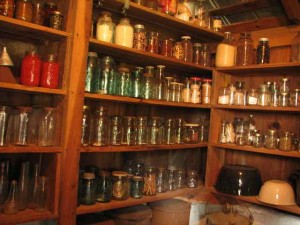 How long will canned foods last? A very long time, according to this article that was printed in FDA Consumer magazine. The original article is no longer available as a current web page, but the archive of the entire article can be found here.
How long will canned foods last? A very long time, according to this article that was printed in FDA Consumer magazine. The original article is no longer available as a current web page, but the archive of the entire article can be found here.
The Canning Process:Old Preservation Technique Goes Modern
by Dale Blumenthal
The steamboat Bertrand was heavily laden with provisions when it set out on the Missouri River in 1865, destined for the gold mining camps in Fort Benton, Mont. The boat snagged and swamped under the weight, sinking to the bottom of the river. It was found a century later, under 30 feet of silt a little north of Omaha, Neb.
Among the canned food items retrieved from the Bertrand in 1968 were brandied peaches, oysters, plum tomatoes, honey, and mixed vegetables. In 1974, chemists at the National Food Processors Association (NFPA) analyzed the products for bacterial contamination and nutrient value. Although the food had lost its fresh smell and appearance, the NFPA chemists detected no microbial growth and determined that the foods were as safe to eat as they had been when canned more than 100 years earlier.
The nutrient values varied depending upon the product and nutrient. NFPA chemists Janet Dudek and Edgar Elkins report that significant amounts of vitamins C and A were lost. But protein levels remained high, and all calcium values “were comparable to today’s products.”
NFPA chemists also analyzed a 40-year-old can of corn found in the basement of a home in California. Again, the canning process had kept the corn safe from contaminants and from much nutrient loss. In addition, Dudek says, the kernels looked and smelled like recently canned corn.
The canning process is a product of the Napoleonic wars. Malnutrition was rampant among the 18th century French armed forces. As Napoleon prepared for his Russian campaign, he searched for a new and better means of preserving food for his troops and offered a prize of 12,000 francs to anyone who could find one. Nicolas Appert, a Parisian candy maker, was awarded the prize in 1809.
Although the causes of food spoilage were unknown at the time, Appert was an astute experimenter and observer. For instance, after noting that storing wine in airtight bottles kept it from spoiling, he filled widemouth glass bottles with food, carefully corked them, and heated them in boiling water.
The durable tin can–and the use of pottery and other metals–followed shortly afterwards, a notion of Englishman Peter Durand. Soon, these “tinned” foods were used to feed the British army and navy.
21 Billion Cans a Year
Canned foods are more than a relic dug from the past. They make up 12 percent of grocery sales in the United States. More than 1,500 food products are canned–including many that aren’t available fresh in most areas, such as elderberry, guava, mango, and about 75 different juice drinks. Consumers can buy at least 130 different canned vegetable products–from artichokes and asparagus to turnips and zucchini. More than a dozen kinds of beef are canned, including beef burgers and chopped, corned and barbecued beef.
According to a recent study cosponsored by the U.S. Department of Agriculture and NFPA, canned foods provide the same nutritional value as fresh grocery produce and their frozen counterparts when prepared for the table. NFPA researchers compared six vegetables in three forms: home-cooked fresh, warmed canned, and prepared frozen.
“Levels of 13 minerals, eight vitamins, and fiber in the foods were similar,” says Dudek. In fact, in some cases the canned product contained high levels of some vitamins that in fresh produce are destroyed by light or exposure to air.
The Canning Process
Food-spoiling bacteria, yeasts and molds are naturally present in foods. To grow, these microorganisms need moisture, a low-acid environment (acid prevents bacterial growth), nutrients, and an appropriate (usually room) temperature.
Dennis Dignan, Ph.D., chief of FDA’s food processing section, explains that foods are preserved from food spoilage by controlling one or more of the above factors. For instance, frozen foods are stored at temperatures too low for microorganisms (bacteria, yeasts and molds) to grow. When foods are dried, sufficient moisture is not available to promote growth.
It is the preservation process that distinguishes canned from other packaged foods. During canning, the food is placed in an airtight (hermetically sealed) container and heated to destroy microorganisms. The hermetic seal is essential to ensure that microorganisms do not contaminate the product after it is sterilized through heating, says Dignan. Properly canned foods can be stored unrefrigerated indefinitely without fear of their spoiling or becoming toxic.
Leave a Reply